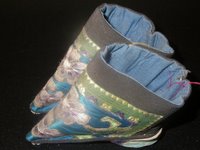Don't worry: it's not that I take these to be the real thing. When I compare what I had to pay, to the prices I find on e-Bay for these items, I either have to conclude that I struck an incredibly good deal, or that I purchased some of these artefacts that roll out of some factory in response to popular tourist demand. I'll stick to the latter option, for the time being. Not that I care. I don't intend to become a collector anytime soon, but just to think of the history behind that kind of shoes made me feel I had to buy it.
Let me first show how they look like:


Isn't it an enormous irony that those who of old were said "to hold up half the sky", -the chinese women in other words- were hardly able to hold themselves upright because of their bound feet that made them rather hobble than walk ? Yet the custom has sustained for over a thousand years. As if these women felt that to mould the world they lived in into a moral universe, of which they had been assigned the keepers, they first had to mould their own bodies into something ... aspiring for more, let's say. The binding of feet, how male-induced it may have been at the core, could not have survived for such a long time if the women, who performed it on their own daughters, were not supportive of it.
There is no way denying the hardship footbinding brought for each and every girl that was submitted to the torture, but look at the shoes -and these may not even be the best of samples- and feel the love and pride that went into them. These shoes were after all the adornment of precisely that what empowered women in a male-centered world: their lotus feet, which purely by concealing them, could drive the men crazy, yet were just as much a token of the characterstrength and the right sense of decorum that could earn the women respect in an otherwise harsh world.
There is an entire new way of research ongoing, steering away from the standard, largely western, christian biased arguments of the early twentieth century anti-footbinding movement and there may be more surprises coming up in the way we view this peculiar custom.








11 comments:
If you're interested, Dorothy Ko has just published a (long awaited) monograph on footbinding entitled _Cinderalla's Sisters: A Revisionist History of Footbinding_. I haven't had a chance to go through it yet, but I've heard a lot of good things so far. Worth checking out.
Hi J.,
Thanks for dropping by.
As a matter of fact, I finished reading "Cinderella's Sisters" already, and I am sure that none of the good what you may have heard about it is exaggerated. The only thing to which Ko is drawing attention, but which lacks a little bit in substance, is the real "corporeality " of the experience of footbinding for the women who had to suffer it. Apart from that -which I admit would be the toughest part, in view of the very private nature and the fact that the custom is extinct- this is one of the best researched examples of scholarship I have ever laid my eyes on.
By the way, congrats also for your blog, compared to which mine completely pales. I happened to run into it just a week or two ago, but I loved it right away. Keep up the good work.
I'm glad you had a chance to read the book and thanks for the mini-review. I've met Dorothy and she's a brilliant historian and a wonderful person.
BTW: I really like your blog, great writing.
(blush, blush ...)
Thanks for the encouragement. I'm trying my best, but I find it is not easy to give a really articulate opinion on a topic in a language other than your mothertongue.
Btw., you guys make me jealous. When Chinalawblog posted a comment on my link to the Phil Borges website, I was informed that he was living right nextdoor. Now you tell me, you've met Dorothy Ko. Am I in the wrong place at the wrong time :-)?
i wish everyone could stop being so negitive about foot binding.
alot of my older relitives have it done and when i was 9 i had mine bound till i was 17 and then i decided to take them out.
it was compleatly my choice but i wanted to see how my great grandmother lived every day life.
my feet are now 4 inches and i love them
i hate how people can say there ugly and its cruel
i think they are beautiful and even though they are now bigger than 3 they are still small
i dont remeber the "extreame pain" which so mainly people say it is.
yer i was in alot of pain and i couldnt always sleep. i wouldnt class that as extreame. having your head run over with a car or being stabed is extreame. this is just a tradition.
im not saying i think it shouldnt have been banned but i just want people to understand that its not as bad as people make out.
iv had alot of negitive feed back, and my mother has unbond feet aswell as most of my family.
i find it easy to walk now, and even though i am 19 my feet are now almost compleatly unbound.
and my doctor said there is no permanent damage
thats all :)
Hi Anonymous,
Thanks a lot for your interesting comment, all the more interesting because you are not the only one who has had that urge to experience how footbinding feels in reality. Take a look here:
http://www.randomhouse.com/boldtype/0302/ping/interview.html
I personally would be the last to put blame on you for having your feet bound, although it is not easy from a male perspective, and I assume also from a modern female perspective, to understand why you would do this to yourself without any coercion from outside.
I however believe you may be misreading a little bit the tendency of my post. The point I wanted to make is exactly that there is new scholarship ongoing (by women, mostly) that is looking at the footbinding tradition in China from a totally different angle than before. Where in the end of the nineteenth, early twentieth century the lotus feet were only an object of despise and ridicule in western eyes, there is now evidence being assembled by these scholars to show that the practice also meant an empowerment of women, that it was a means of social bonding between them and that it, definitely by the time of the Ming dynasty, belonged more in the realm of fashion and female decorum than in the realm of male subjugation.
I would love to learn more about your personal experience, the why, the how etc..., if you feel comfortable speaking about it. You of course can also drop me an e-mail. You are sure to have my full attention :-)
Sorry, that link above was apparently too long, so I've shortened it here:
http://tinyurl.com/2ebjzk
Outstanding post....!!!!!Do you want Tiny little shoes????Come lets go Timberland shoes
Hi Lao Lu!
I red Your writings about footbinding and specially "anonymous" writings.I lived in China 1980-1990 and I can say that there was not anymore young footbinding on that time.It is simple impossiple to work , study or liv normal sosial life with bound feet in so young age.
So story is fairy tale.
it is a good share,wonderful post,thank you
One of my ancestors brought some lotus shoes back from China in, I think, the second half of the 19th century. I've posted a picture of them at http://hourglassera.com/family-memorabili/knowles-ireland-and-fletcher-family-memorabilia-2/ .
If anyone could help me to date them more precisely, I would be grateful. Just leave a comment on the page.
Post a Comment